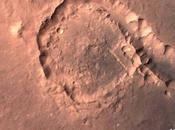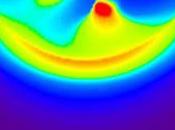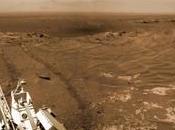
Crediti: NASA/JPL-Caltech.
Questa immagine artistica vuole rappresentare un sistema planetario in miniatura, così compatto che si può confrontare con il sistema planetario di Giove e dei suoi satelliti, piuttosto che quello di una stella e dei suoi pianeti.
I ricercatori, utilizzando i dati ottenuti dalla missione Kepler della NASA e con i telescopi terrestri, hanno recentemente confermato che il sistema, chiamato KOI-961, ospita i tre esopianeti più piccoli finora osservati in orbita attorno ad una stella diversa dal nostro Sole. Un esopianeta è un pianeta che si trova al di fuori del nostro sistema e che fa parte di un altro.
La stella, che si trova a circa 130 anni luce di distanza dalla terra nella costellazione del Cigno, è una nana rossa, con un sesto delle dimensioni del Sole, circa un 70% più grande di Giove. La stella è anche più fredda del nostro Sole, e irragia più luce rossa che gialla.
Il più piccolo dei tre pianeti, KOI-961.03, si trova in questo momento più lontano dalla stella, ed è raffigurato qui in primo piano. Questo pianeta ha dimensioni confrontabili con le dimensioni di Marte, con un raggio 0,57 volte quello della Terra. Il pianeta successivo, in alto a destra, è KOI-961.01, pari a 0,78 volte il raggio terrestre. Il pianeta più vicino alla stella è KOI-961.02, con un raggio pari a 0,73 volte la Terra.
Tutti e tre i pianeti compiono una rivoluzione con un periodo inferiore ai due giorni, con il pianeta più vicino con un periodo pari a circa 12 ore terrestri. La loro vicinanza alla stella fa sì che risultino essere corpi caldissimi, con temperature che vanno da 176 ai 447 °C. La zona abitabile della stella, osssia la regione dove l’acqua liquida si trova allo stato liquido, si trova ben oltre i pianeti.
Le osservazioni compiute con i telescopi terrestri che hanno contribuito a questa scoperta sono state fatte dall’Osservatorio Palomar, vicino a San Diego, California, e dal WM Keck Observatory sulla cima del Mauna Kea alle Hawaii.
English Version
Mini Planetary System
This artist’s concept depicts an itsy bitsy planetary system — so compact, in fact, that it’s more like Jupiter and its moons than a star and its planets. Astronomers using data from NASA’s Kepler mission and ground-based telescopes recently confirmed that the system, called KOI-961, hosts the three smallest exoplanets known so far to orbit a star other than our sun. An exoplanet is a planet that resides outside of our solar system.
The star, which is located about 130 light-years away in the Cygnus constellation, is what’s called a red dwarf. It’s one-sixth the size of the sun, or just 70 percent bigger than Jupiter. The star is also cooler than our sun, and gives off more red light than yellow.
The smallest of the three planets, called KOI-961.03, is actually located the farthest from the star, and is pictured in the foreground. This planet is about the same size as Mars, with a radius only 0.57 times that of Earth. The next planet to the upper right is KOI-961.01, which is 0.78 times the radius of Earth. The planet closest to the star is KOI-961.02, with a radius 0.73 times the Earth’s.
All three planets whip around the star in less than two days, with the closest planet taking less than half a day. Their close proximity to the star also means they are scorching hot, with temperatures ranging from 350 to 836 degrees Fahrenheit (176 to 447 degrees Celsius). The star’s habitable zone, or the region where liquid water could exist, is located far beyond the planets.
The ground-based observations contributing to these discoveries were made with the Palomar Observatory, near San Diego, Calif., and the W.M. Keck Observatory atop Mauna Kea in Hawaii.
Image credit: NASA/JPL-Caltech
Fonte NASA: http://www.nasa.gov/mission_pages/kepler/multimedia/images/mini-planetary-system.html
Sabrina






